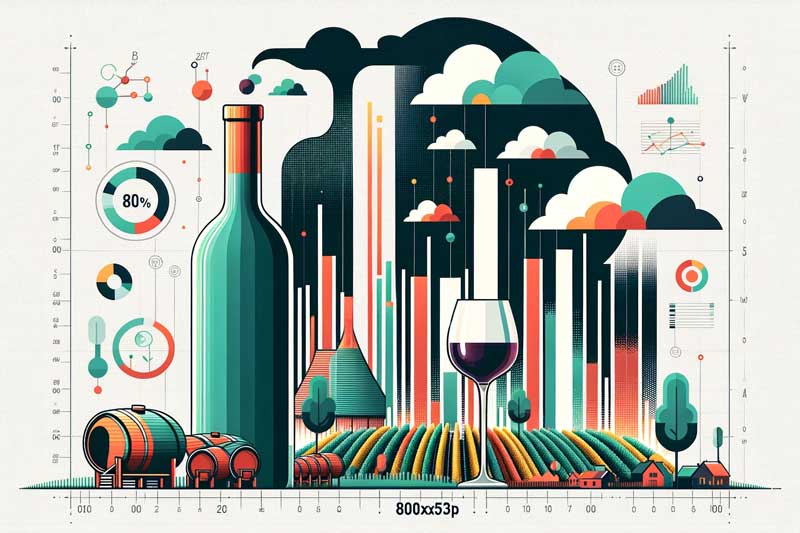Already feeling the effects of climate changes, vineyards are now looking inward to see how they can do their part to help reduce carbon emissions. At the heart of this battle lays data analytics, which vineyards are employing to not only identify their current rate of emissions, but how they can lower them as well.
Sustainable packaging
The packaging of wine significantly contributes to its overall carbon footprint, with estimates suggesting it accounts for around 70% of total emissions. To tackle this, the industry is seeking innovative solutions.
Tools like the WineGB Carbon Calculator, developed by Sustainable Wines of Great Britain, enable wine producers to calculate and understand their packaging-related emissions. SWGB is also launching a web-based data repository where producers can anonymously add data. This initiative aims to benchmark against others in the industry, identify areas for improvement, and formulate effective strategies for emission reduction.
Companies like UPM Raflatac are developing tools such as The Label Life Tool to aid vineyards in choosing sustainable packaging materials. Based on life cycle assessment (LCA), these tools provide calculations on greenhouse gas emissions, energy use, and water consumption, helping wineries make environmentally conscious choices.
Efficient transportation
Transportation is another significant contributor to carbon emissions in the wine industry. Although delivery trucks and tractor trailers constitute a mere 4% of the vehicles on U.S. roads, their environmental impact is disproportionately large. These vehicles account for almost half of the nitrogen oxide emissions and around 60% of the fine particulate matter emissions from all vehicles in the United States, according to the Environmental Defense Fund. Furthermore, they contribute to approximately 7% of the country’s total greenhouse gas emissions.
The use of AI and machine learning in data analytics can help cut down these emissions by optimizing logistics operations and improving fuel efficiency. This includes monitoring data generated by logistics activities such as volumes, distances, mode selections, and identifying patterns of inefficiency.
AI-powered data analytics are also instrumental in reducing unnecessary travel, such as deadhead miles, by improving loading and routing. By analyzing data on traffic patterns, weather, and historical drive times, AI can predict better routes, thus optimizing transit time and reducing excess emissions.
Vineyard activities
Vineyard management practices have a significant impact on carbon footprints. For instance, the combustion of fossil fuels during operations like tractor driving and irrigation pumps contributes to the GHG footprint of vineyards. Soil management practices that increase soil organic matter decomposition also contribute to atmospheric CO2. Agricultural activities also emit nitrous oxide (N2O) and methane (CH4), with N2O being a particularly potent GHG. The importance of N2O comes from its strong ability to act as a GHG, being roughly 300 times more effective than CO2 at trapping heat in the Earth’s atmosphere.
While many of these emissions can’t be totally eliminated, they can be drastically reduced through data analytics. The more data vineyard managers have access to, the more context they have for their decision-making. This means less excess fertilizers, water spent on irrigation, and soil damaged during tilling.
A project by Washington State University aims to develop decision-aid tools for vineyard nutrient management. These tools include remote sensors and modern plant tissue sampling protocols, enabling real-time, in-field access to vine nutrition data. This project underscores the importance of precision nutrient management, reducing environmental impacts and improving crop yield and quality. The project’s objectives include the development of non-destructive tools for measuring grapevine nutrient status and defining grapevine nutrient ranges based on environmental conditions and production markets.
Soil moisture sensors have also become instrumental in providing data necessary for effective irrigation scheduling. By measuring water status during dormant and active seasons, these sensors help in understanding how water moves in soil and where roots are most actively absorbing water. This technology is essential for avoiding over-irrigation and optimizing water use efficiency, thereby reducing the carbon emissions associated with excessive water application.
Learn more
Technological innovation and global warming have collided within the wine industry as businesses seek to lower their carbon footprint through data analytics. Curious about how else data analytics is being used in the wine industry? Check out our white paper—”Wine and Spirits Technology Landscape—Bridging the Gap with Analytics.”
- How Spirits Brands Can Improve Brand Loyalty with Data Analytics - January 30, 2024
- The Collapse of Herbl, and How Other Cannabis Distributors Can Avoid the Same Fate - January 24, 2024
- Top 5 Blog Posts of 2023 - December 28, 2023



